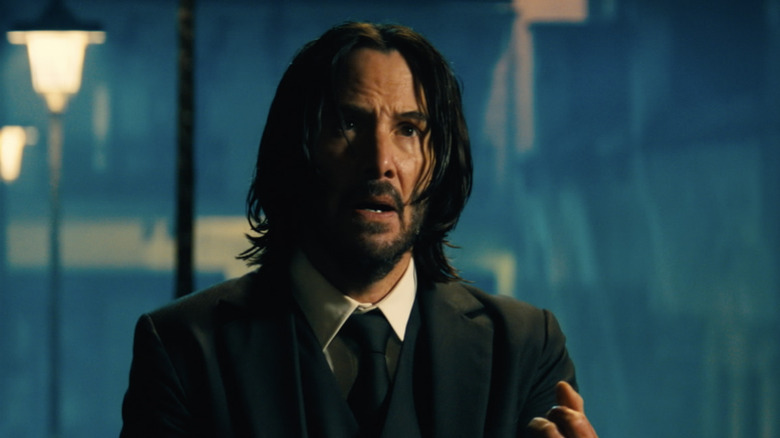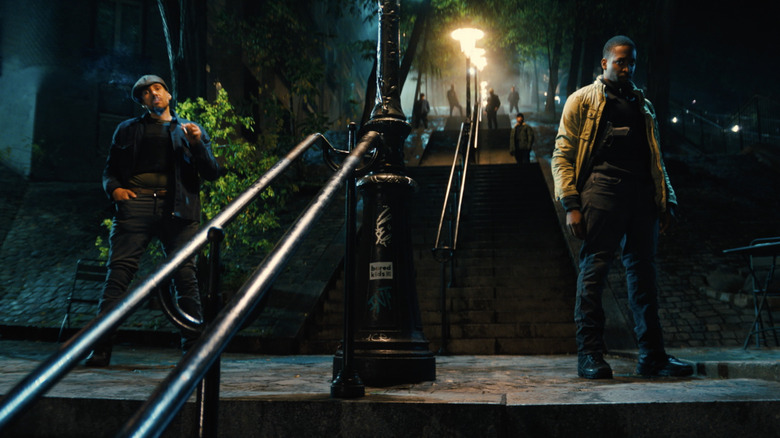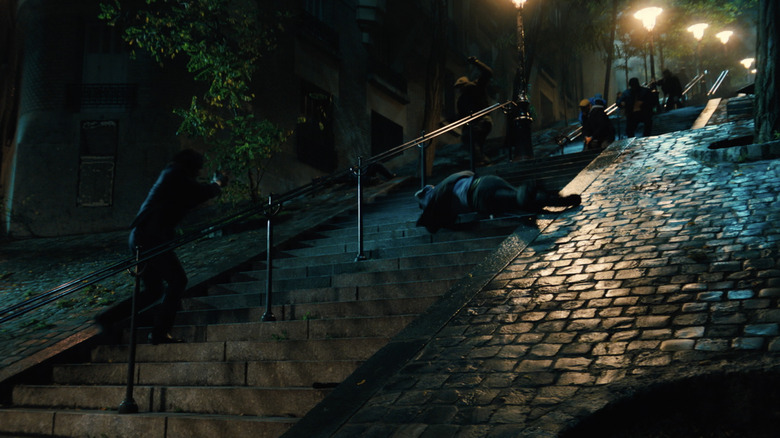How The John Wick 4 Stunt Coordinators Pulled Off That Jaw-Dropping, Back-Breaking Stairs Scene [Exclusive]
This post contains spoilers for "John Wick: Chapter 4."
For what could very well be the final major set piece in the mainline "John Wick" series (spinoffs are coming), it makes sense that director Chad Stahelski and his incredible team of stunt performers would want to create the biggest, loudest scene they could. The climax ends up being a triptych of a sequence that takes place at three different locations: the Arc de Triomphe, an abandoned house of some kind, and finally the massive staircase leading to Sacré-Cœr. Some, including myself, would say it's a bit too much action, but there are unquestionably moments within this nearly 40 minute stretch that I marveled at.
Mostly, this occurred on the staircase, with dozens of assassins attempting to take down Keanu Reeves' titular hero before reaching the top for his duel with the Marquis de Gramont (Bill Skarsgård). Where it differs from the previous two sections is that there is a clear objective for Wick other than simply not dying: he needs to get to the top of the stairs before sunrise. We know his goal and completely understand the geography, clearly seeing when he makes progress and when he takes a step back ... or ends up falling all the way down the staircase. It's simple and effective in its setup and lets the dramatic complications come from the choreography.
Keeping things so crystal clear and hard-hitting in a very linear scene like that seems like it would be rather simple compared to other action set pieces in the "John Wick" franchise, but of course, it needed to be carefully designed down to the most minute details. Luckily, the location itself presented a perfect way to build out the sequence.
Finding the levels
With a location like a staircase, many fight choreographers could wind up finding themselves in a bit of a conundrum: The objective to get to the top may be clear, but the location's inherent repetitive nature adds an additional challenge for delivering a satisfying action set piece. While the staircase outside of Sacré-Cœr has several hundred steps for people to walk up, that doesn't mean there is a constant incline to endure. Every couple dozen steps, there is a landing for people to take a breath at. Recognizing this construction, fight choreographer Jeremy Marinas could then break down this massive fight into a series of smaller fights that escalate and tell a story. Speaking with /Film's Vanessa Armstrong, stunt coordinator Stephen Dunlevy said of the set piece:
"Thankfully there's levels. So you just take each level, obviously, at a time. You've got to break it up each stunt. With anything we're doing, we're breaking up sections at a time. So we take each level and you build up on top of those levels like a pyramid ... John Wick goes up and he fights a bunch of guys, Marko [Zaror] kicks him down, and then you have Donnie Yen. We introduced Donnie Yen into that, which is a whole other element of getting to work with Keanu and Donnie, both of them going up the staircase together."
Being able to focus on each level individually lets the sequence naturally evolve and escalate, even if ultimately it's a lot of shooting and punching. But of course, the main attraction here is John Wick's falling down the staircase, which is an absolutely breathtaking stunt that I felt pain just watching.
The fall
Just when you think John Wick has made it to the top of the staircase, Marko Zaror, playing the Marquis' right-hand man, kicks John Wick halfway down the staircase, followed by throwing him off a lamp post that sends him down to the bottom. In long takes, we see Wick tumbling down level after level to the point where it's almost comical (but isn't). Dunlevy said of shooting those falls:
"We had the amazing Vincent Bouillon, our John Wick double, who did that fall all the way down ... I think we fell for about two days straight with the different shots in that sequence. And you want to make sure that he can get up after each time."
That's so many times to fall down several flights of stairs. Yes, Bouillon is covered in gel pads, but no matter what, he's definitely going to feel that the next day. The major centerpiece of that fall is the continuous take of him going down four or five levels. And Bouillon had to do that multiple times. Fellow stunt coordinator Scott Rogers, who also served as the film's second unit director, told /Film of the stunt:
"[T]he full length that you see in the shot, he did four times ... It was one of the most impressive days of a performer I've ever seen in my 32-year career."
For someone who's worked on projects including "Spider-Man 2" and "The Bourne Ultimatum," that's high praise. And deserved. Dunlevy echoes it and assures that Bouillon "knew exactly where he was on that stair fall. He was in control the whole time." I know I wouldn't be. I'm in awe of people putting their bodies on the line like that for art, and hope they think it's worth it.


